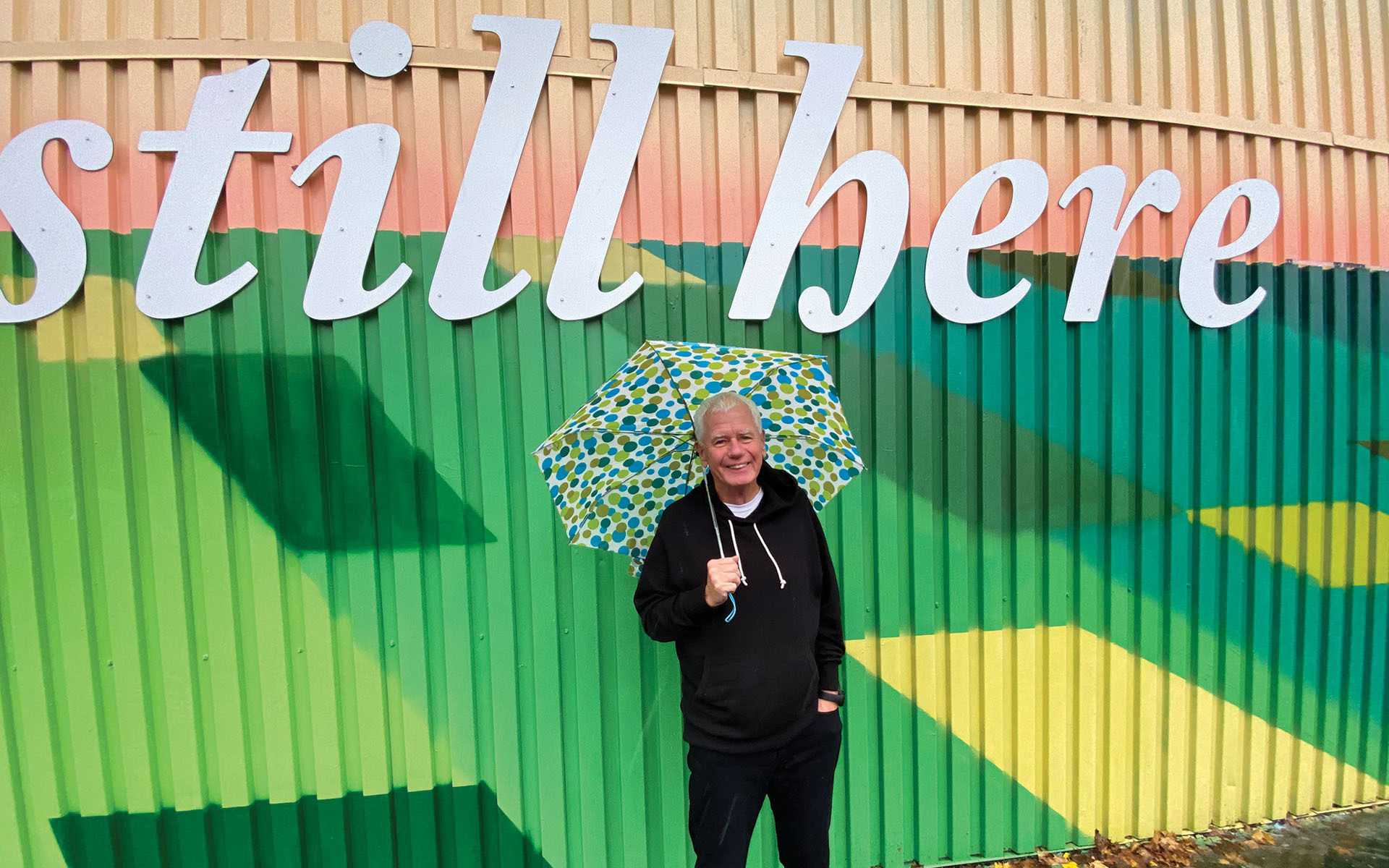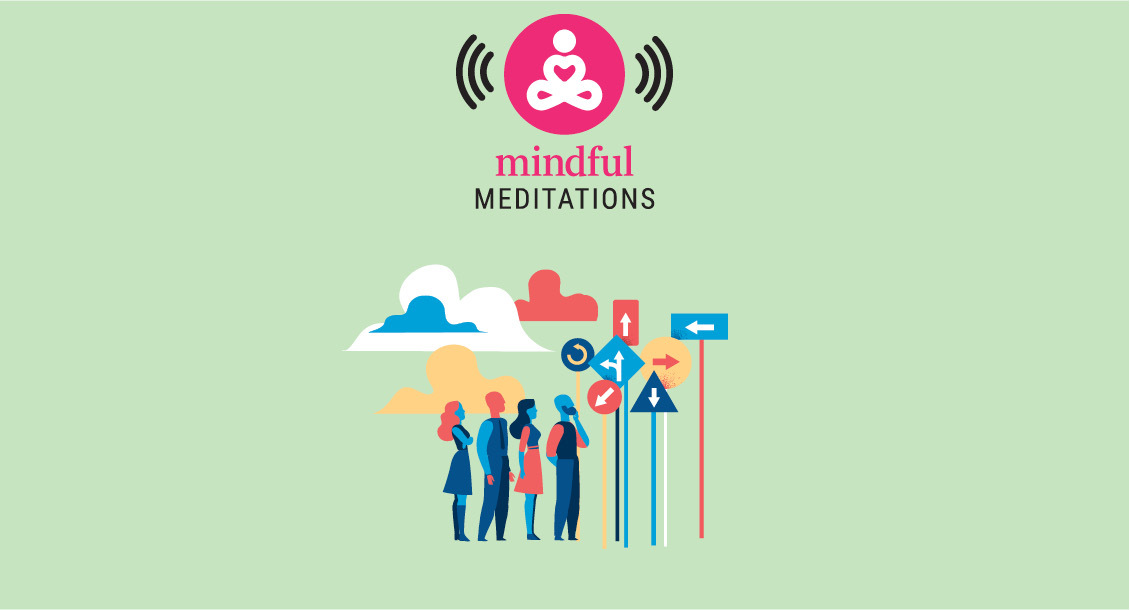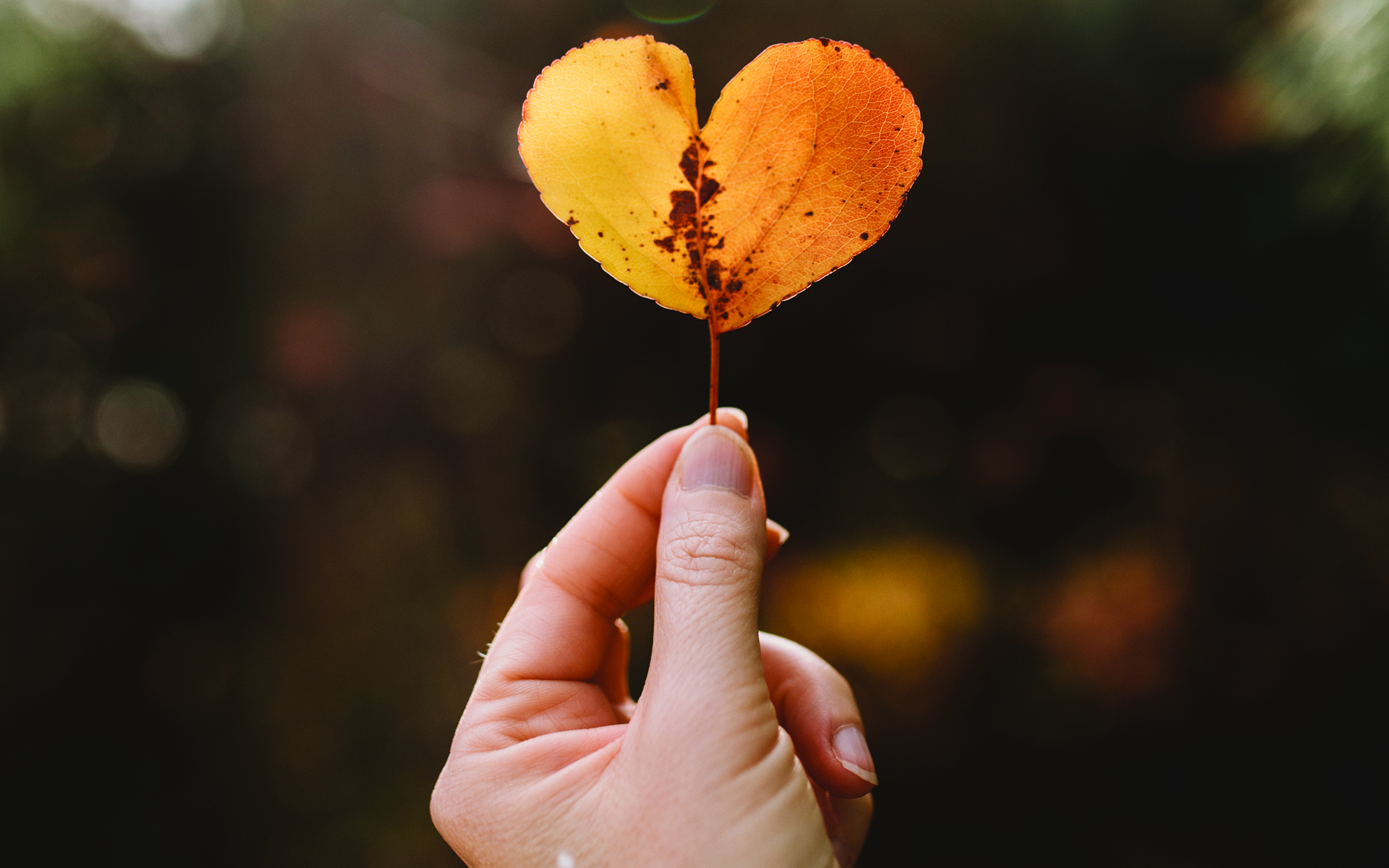Frank Ostaseski is a well-known and much-loved teacher of meditation, mindfulness, and compassionate service. The author of The Five Invitations: Discovering What Death Can Teach Us About Living Fully, Ostaseski cofounded the Zen Hospice Project, and has helped more than a thousand people on their way to dying.
In July 2019 a serious stroke affected his brain’s capacity. In the ensuing two months he had four more strokes, and as many aspects of daily life became more difficult, Ostaseski found strength and refuge in love, compassion, and curiosity. He also found his practice still very much alive through the whole experience—and his ability to communicate the nuance of what we discover when we welcome everything remains intact. Here, he shares some of what he learned and leaned on with his longtime friend, Mindful’s founding editor Barry Boyce
Barry Boyce: Frank, can you describe what the experience of your strokes and seizures has been like for you?
Frank Ostaseski: The first stroke woke me with severe pain that felt like someone was taking a welder’s torch across my skull. My wife, Vanda, was amazingly calm and resourceful. She called the hospital and they said she should get me in right away. So, the first stroke was the most serious, but in the next two months I had another four strokes, which varied in symptoms and severity.
Even though my brain was going through this calamity, my awareness was conscious. Awareness could watch my brain go offline, watch my inability to tell night from day, to track time, my inability to find my way back from the toilet to our bedroom. “Frank” was frightened; but awareness wasn’t. So, there was Frank, the personality that observes and reacts. But, anyone who’s done even a little mindfulness practice is conscious that a more expansive quality of awareness is available. It has no need to exclude anything, so it can include and welcome everything. That’s what was in play at that moment. Now, without getting too technical here, we can be aware and not know. I was aware, even though I didn’t understand that it was a stroke. I was aware of losing my sense of time. I was aware of losing any sense of direction.
BB: Can you say more about that distinction between being aware without knowing and being aware with the quality of knowing?
FO: Knowing requires an ability to correlate what we’re experiencing to something in our databanks. There can be awareness without naming or differentiation. Infants see color and shape and patterns but cannot name or differentiate patterns.
Perception is the process by which we make the indefinite, definite. My perception coalesced very slowly. I would see something rectangular and yellow and black. Then slowly, it would coalesce into a school bus. It wasn’t that I didn’t know the words “school bus,” but perception was altered, the pattern of color and shape wasn’t recognizable. Now, if hindered perception makes it difficult to recognize a school bus, it makes it similarly difficult to recognize the conventional sense of self. A recognition of Frank would also coalesce slowly. My normal identity, what I thought of as me, wasn’t coming into a recognizable form.
My normal identity, what I thought of as me, wasn’t coming into a recognizable form.
For many people this is a frightening state. There are no reference points, no familiar self. However, due to my practice I was familiar with “non-conceptual awareness,” an awareness that isn’t filled with concepts or knowing. A pure openness.
My strokes affected the visual processing area of the brain—my eyes are fine, but my occipital lobe was injured, and my brain doesn’t translate the images coming in through the retina. I’ve lost over 50% of my vision. Yet this experience has provided insight into how we normally see and this has inspired a more expansive vision of how our superficial and limited ways of seeing lead to misperception and ultimately a sense of separation.
The strokes also altered my sense of time and space. I often don’t know what day it is. When someone says, I’ll be back in a minute, I don’t know how long that is. In our current conversation, I don’t know if we have been talking for five minutes or an hour.
The strokes also reduced impulse control. When I came home from the hospital after the first stroke, the healthcare people were very concerned, because my houseboat is unstable and my balance was off, so they were very worried that I would act impulsively and fall down the stairs.
BB: Your houseboat has two floors, right?
FO: Yes, an upstairs and downstairs. One morning, standing at the top of the stairs, I realized I could easily fall. And
if I fell, that would cause a great deal of suffering for my family. I had an image of my grown son at the bottom of the staircase. I imagined how much pain my falling would cause him. I felt a welling up of love for my son. The love was so supportive and strong. It was as stable for me as the handrail. And so any time I went down the stairs, I would invoke an image of my son and my love for him. It was a stable support for me to navigate the world that had become very difficult to navigate. It wasn’t just an emotional state; the love had the quality of inner support.
BB: And you would say you instinctually stumbled into that discovery?
FO: I stumbled into the discovery through the experience of empathy. If I hurt myself, it would hurt them too,
right? Empathy became a doorway to compassion. I wanted to relieve that possibility of suffering. That is compassionate action. So, I had to make a vow to myself that I would be very careful. And the driving force for that vow was love.
BB: You had to rely on a bigger sphere, in a sense, than the more immediate, ego-oriented sphere of “I need to control things in order not to hurt me.”
FO: Exactly. When we train ourselves in mindfulness, we can become more conscious of our inner and outer worlds and what motivates our actions. I’ve spent most of my adult life in service, cultivating the quality of compassion. So, it’s very stable in me. And I think it surfaced as a kind of guidance.
BB: How did that experience strengthen your confidence in that ongoing continuity of awareness we talked about earlier, in the face of the loss of so many reference points?
FO: My confidence in what we might call our “natural awareness” was a well-established practice in my life. However, in the past, if I forgot about natural awareness, I would slip into functioning only from Frank’s personality. But now, the functionality of Frank’s personality was not reliable. My trust in natural awareness became more stable and served as my primary guidance.
BB: I’ve known you for decades. And I’ve seen a lot of different Franks, and you’re another Frank now, clearly. There is both change and continuity.
FO: I don’t think our mindfulness practice is about having some kind of transcendent experience or arriving at some plateau from which we never fall. The experience with my strokes was humbling. It reminded me that our practice doesn’t protect us from bad things. It gives us the capacity to work with them when they arise. Practice can shift how we see our- selves, who we understand ourselves to be. We are more than the small separate self we have taken ourselves to be. We are awareness, pure openness.
BB: Could you say something about what you experienced last February?
FO: I was sitting at my desk and suddenly I was aware of the impermanence of things; everything, even the solid walls, appeared pixelated. At first it was interesting. And then I thought, “Oh, you could be having another stroke, Frank.”
Vanda called the emergency services. She told me that they’d arrive shortly with a gurney and wheel me down to the dock; which is about a four-minute walk to the parking lot.
I said, “No, I want to walk.” Maybe it was stubbornness but I wanted to feel my feet. When I stepped on the dock, my whole being was infused with love—as if every cell in my body filled with love. It wasn’t something I was trying to evoke or promote; it simply was there, as a kind of guidance. It wasn’t only emotional love, it was stable, supportive, and in a way impersonal but very real. Like my experience on the staircase. I could lean into it.
Every cell in my body filled with love. It wasn’t something I was trying to evoke or promote; it simply was there, as a kind of guidance. It wasn’t only emotional love, it was stable, supportive, and in a way impersonal but very real.
As I walked, I was unstable on my feet, and I had to hold on to Vanda’s arm. But internally, I was very stable. About halfway down the dock, I stopped to look over the railing at the water. And then something changed. The supportive quality of love sub- sided and a new quality started to emerge. I would call it “dissolving love.” Love was dissolving everything, any sense of Frank, any sense of me being separate from anything else.
And as it dissolved, I experienced something which, without getting fancy, I would just call absence. Absolute absence of any boundaries or familiar references. It felt real and true, and in a way ordinary. There was awareness and pure openness. No me, but there was consciousness of the experience.
As we got to the parking lot, I saw an ambulance drive up. As the paramedics got out, I began to have a grand mal seizure. They caught me as I fell. It must have been very frightening for Vanda—my body going rigid and shaking.
BB: Had you had seizures before with other strokes?
FO: Never.
BB: Oh, this is new territory…
FO: Completely new territory. They put me in the ambulance. They gave me medication, I went unconscious and they took me to the hospital. No awareness at all. Very different from the absolute absence. I was unconscious when they wheeled me into the emergency room. After a while, I vaguely heard voices. I learned later that it was Vanda and the doctor confirming my end-of-life wishes, including no CPR. The doctor questioned this and Vanda said she was uncertain. Apparently, I raised my arm, and I said clearly and unmistakably, “No CPR!” I don’t know where that came from. It was as if I was emerging from a dark well, but I said it.
No, but then I started to become conscious again. The medications I was given can be mood-altering. I had just gone through a very traumatic experience. These and other factors combined to make me quite delusional and paranoid. I couldn’t find a way for my mind to work with the delusion. The techniques we use in mindfulness—sensing the body, calming the mind—were not helpful. But awareness was there. I have deep trust in the truth of impermanence and so I began to repeat a very simple phrase: “Right now, it’s like this.” That’s about all I could manage. The paranoia lasted for almost 48 hours. It was a hell realm.
BB: Ouch.
FO: I asked my teacher about this experience. I said, “Suppose this was the moment of my dying, and I first felt this angelic and supportive love and then this paranoia?” He said, “Oh, it would be all right.” I asked, “What do you mean, it would be all right? I might die in utter confusion!”
He continued, “Well, it doesn’t surprise me that you experienced that love. You’ve been cultivating loving awareness most of your life. It would naturally be there to support you. And when you died, your brain would stop and the paranoia—which is a function of your brain—would also stop, and awareness would return.”
We are more than our illnesses, more than our history, more than our limiting ideas of self.
So that was a very deep teaching and very useful for me. We are more than our illnesses, more than our history, more than our limiting ideas of self. Our mindfulness practice has to be creative and fluid. It’s not sufficient to simply calmly observe. We need insight.
BB: Isn’t calmly observing a conventional gateway to that possibility of seeing? I’m just going to watch this movie of life so I can be calm about it.
FO: If you want to be calm, I’ve got some tea that I can give you—but that doesn’t necessarily provide any insight into your life or the nature of our suffering in our world. We need understanding, we need clear comprehension.
BB: There have been many attempts to measure the quality of meditation practice and almost all of them seem to rely on measuring some state of calm. But in the experience of insight, you may be completely rocked by something, but it’s the remaining or returning to some connection to greater awareness that truly counts, so calm is not a measure of insight or wisdom.
FO: Yes. Calmness, concentration, and tranquility can allow us to see more deeply into our situation, which can give rise to wisdom. But it doesn’t always work that way. I couldn’t calm myself in the paranoia. Sensing my body, watching my breath, were not sufficient to work with this difficult state of mind. However, my practice gave me the energy to persevere, to remain mindful, to temporarily find ease, and call on the wisdom that has been cultivated through practice. That is what led me to say, “Right now, it’s like this.”
BB: One of the significant things about “Right now, it’s like this,” is that it’s very direct and non-discursive. You know, it’s not a little pep talk. It’s not a narrative.
FO: Yes, and it’s also not a fix, it’s just a statement of truth.
BB: You often say the part of you that is aware you’re in pain isn’t in pain, and in this case, the part of you that was able to say, “Right now, it’s like this” is aware there is more to you than your paranoia. But it may get overtaken again. It’s not like for 48 hours you can just say once, “Hey, I’m cool.”
FO: No. And it wasn’t skillful to just keep sensing my body and watching my mind. I needed to place my mind on something that was stabilizing. The phrase stabilized my mind, heart, and body.
BB: One of the classical metaphors for skillful means is some kind of a weapon, such as a sword. It’s something that needs to be available to be wielded. Your training gave you that weapon, as it were.
FO: Exactly. And if I had only trained in calming the mind, heart, and body that wouldn’t have been enough. The phrase was a skillful means to cut through delusion—the sword of discriminating awareness that helps us discern the truth of the moment.
The simple metaphor of the ocean and the wave describes a sense of oneness or interdependence we have with all things, the lack of separation. But another way to understand it is: At the surface, wind and other conditions are creating waves. A wave isn’t innately different from the ocean, it’s still wet and salty. But conditions are making it into a wave. It’s just the ocean taking that shape. But any scuba diver will tell you that if you drop down deep in the sea, you’ll find calmness. That is also true of our minds. The surface of our mind—the ordinary, everyday mind—is constantly being windswept by conditions, history, trauma, etc. However, there is a dimension of mind that is always calm and will not abandon us. We can rely on it. It doesn’t require being somebody special or becoming enlightened. It is naturally occurring. Mostly, we’re so preoccupied with what’s at the surface that we don’t always recognize the deeper dimensions of mind. Training is required in order to know it. We shouldn’t underestimate the need for good training. If you want to scuba dive, it’s a good idea to take a few lessons before you dive 40 or 50 meters below the surface of the ocean.
But loving awareness isn’t the sole domain of enlightened beings, it’s available to everyone. Just like it takes practice to learn to scuba dive, we can all learn to have confidence in deep mind and become skillful in navigating difficult states of mind, body, and heart.
BB: It seems at times we’re drawn to the notion that we could live down there at the bottom of the ocean, and we set up this dichotomy that the surface is a problem we need to escape from. But we always need to navigate the surface, right? Even though we have that depth available.
FO: Early in our life, we tend to split off or bifurcate the personality from the deeper dimensions of our being. It
is essential that in our practice we realize that the windswept surface of mind is not separate from or something other than deep mind.
BB: I want to touch on something that you talked to me about not long after your first stroke, about sequencing.
FO: So, the part of my brain that was damaged relates to time, space, direction, and sequencing. So, when we would say, “Let’s go to the supermarket, and on the way we’ll stop for a coffee and maybe on the way back we’ll get a bite to eat.” Those are things that my brain cannot track so well. It’s difficult for me to put tasks or activities in order. Putting things in order is part of how we make sense of things. It’s part of how perception functions. We see color, shape and then there’s that almost seemingly automatic recognition of school bus. It is actually a process of sequencing. If that capacity isn’t there, then our ability to recognize patterns and perceive the world as we perceived it before is dramatically altered.
BB: Now, how is it that you didn’t just crumble in the face of the lack of such basic reference points?
FO: Well, I did crumble often. I’m nobody special. I just kept learning from the experience and sometimes I would just take to my bed, curl up in a fetal position and weep. And sometimes that’s how it is, right? And so, we have to recognize that that’s not the only way it is, but it is that way now.
I don’t think we can be free if we are rejecting any part of ourselves, including the parts that are not so functional or damaged in some way.
BB: As you’re talking about the need to include all the parts of yourself, it reminds me of how we often talk about othering and compassion. If everybody isn’t included, no one is included, in a sense. So, you’re saying that also happens in the realm of all the different parts of one’s own being. It begins there.
FO: It happens on the micro and macro levels. This human life is at times fragile and vulnerable. That is a way reality takes shape. And whenever I argue with reality, I lose. Impermanence isn’t the cause of our suffering. We rely on change, on impermanence. The cold you have today won’t last forever. Pandemics are resolved, presidential terms end. It’s funny, we all pretty much agree that life is in constant flux. Seasons come and go, trends peak. Yet we cling to the illusion that we are solid things moving through a changing world— everything is changing except me. But we are mistaken. When we embrace impermanence, a certain grace enters our lives. We are free to savor life, to touch the texture of each passing moment whether the moment is one of sadness or joy.
When we embrace impermanence, a certain grace enters our lives. We are free to savor life, to touch the texture of each passing moment whether the moment is one of sadness or joy.
It helps me to recognize that challenging experiences like illness are not adversaries, but rather something that may have some value for me. Now, I can’t see the value if I’m helter-skelter, but if I’m stable and mindfully engaged in open-ended inquiry I may learn something unexpected.
After the first strokes, my doctors often spoke about recovery. The limitations I might face and the benefits of neuroplasticity, which we speak about in mindfulness circles all the time. I came to realize that I was more interested in discovery than recovery. I may never recover the capacities I lost but I am interested in seeing what this experience of stroke and its aftermath might show me about myself and life. This is my path now, to keep discovering. Curiosity promotes a quality of resilience which is very helpful. It doesn’t require hope that I will one day recover everything I’ve lost. It requires only that I trust and continue to be open and be willing to not know.
BB: Well, that’s a meta-metaphor, if you will. Because, when we think of COVID and the narrative that we’re going to get back to normal…
FO: I think going back to normal is a lack of imagination. I don’t think we go back. We include and go forward. In my case, if I only hold out for recovery I am surely going to suffer.
BB: Yeah, this isn’t just a kind of trite, birthday-card slogan: “discovery over recovery.” You needed that.
FO: Absolutely. It requires a willingness to live into the unknown. So often we trade truth for comfort. It’s a bad deal. We need mature hope—not just the flipside of fear. Mature hope requires both a clear intention and a simultaneous letting go. This hope is not dependent upon outcome. In fact, hope is tied to uncertainty because we never know what is going to happen next.
Most of us don’t grow in our comfort zones. We grow when we realize we are no longer able to control all the conditions of our lives, and are therefore challenged to change ourselves. When we release our clinging to what used to be and our craving for what we think should be, we are free to embrace the truth of what is in this moment.
Read More
A 12-Minute Meditation to Cultivate Presence and Awareness
Bring mindfulness to your sensory experience by exploring your visual field.
Read More
How Embracing Uncertainty Leads To Fulfillment
When we hone our attention to the subtleties of impermanence that are inherent in every breath, we step into our lives with integrity, compassion, forgiveness, and love.
Read More
How I Found My Way to Gratitude
Whether you think of it as the “greatest virtue,” as Cicero did, or “social glue,” as researchers do, gratitude has the power to change your life, if you let it. Kelly Barron shares how she learned to let gratitude change her.
Read More




